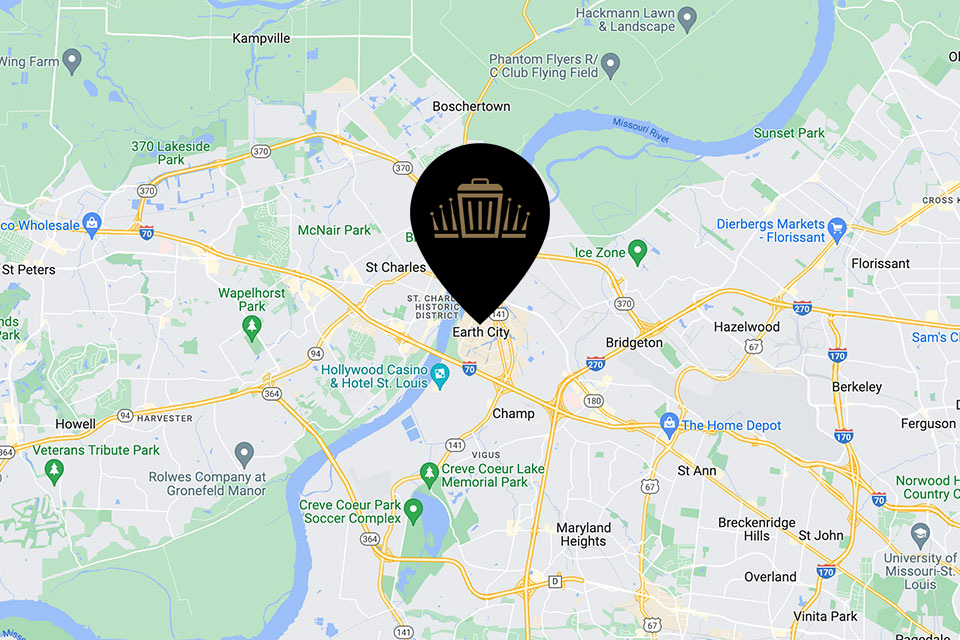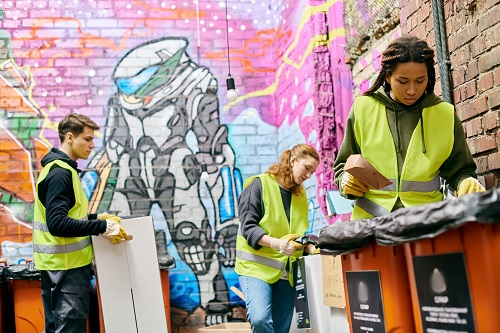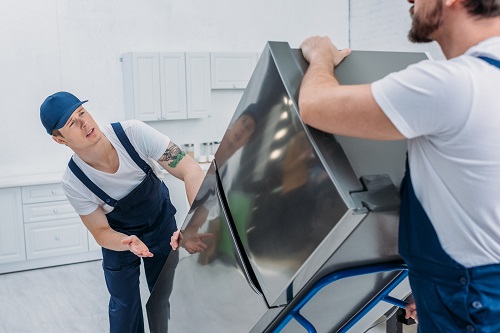Business and Commercial Cleanouts
Business and commercial cleanouts refers to detoxing offices, shops, or work areas of outdated furniture, equipment, files, and junk. Businesses need cleanouts when relocating, downsizing, or renovating. Safe handling and disposal of items, coupled with recycling and data shredding, constitute important steps to clear space, comply with safety regulations, and maintain tidiness. The following sections detail how to organize and complete business cleanouts one step at a time.
GET A FREE ESTIMATE
What will it cost for us to remove your junk and take it to a disposal site? We would love to provide you with an approximation of the final price. All you have to do is give us some information about the cleanout or demolition project you have in mind. Please fill out the nearby form.
Understanding The Scope
Business and commercial cleanouts come in a huge field of services, each with their own tasks and challenges. Cleanouts can involve office moves, store shut-downs, warehouse clear-outs, industrial locations and reconstruction debris. The scope varies, from daily tasks like emptying bins and cleaning bathrooms to monthly deep cleaning such as floor waxing or dusting.
The right planning and scheduling, customized for each business type, maintains spaces safe, healthy, and ready for use every day.

Office Transitions
Office cleanouts have you beginning by organizing and packing your belongings to relocate, then eliminating unneeded furniture and devices. Businesses have to figure out what remains, what leaves and who does what. Purge those old chairs, desks and electronics.
Anything that can clutter your new work areas and delay the move! Commercial cleaners can handle these steps, carting away what’s unnecessary and scrubbing out every nook and cranny. It helps teams zero in on their work and reduces downtime. Clear, clean work spaces lift spirits and help your staff get back to business.
Retail Closures
Retail store cleanouts present their own special problems. Store layouts, residual inventory and built-in fixtures can all contribute to removal difficulty. Dealing with deadstock involves either recycling, donating or safely disposing in accordance with local regulations.
Cleanout crews know how to disassemble shelving, categorize inventory and dismantle showcases without harming in-store fixtures. They further assist stores to donate usable items to charities, reducing waste and supporting community organizations. By working late or during slow periods, you keep interruption to a minimum, allowing employees to concentrate on wrapping things up.
3. Industrial Sites
Industrial cleanouts need rigid safety regulations. Crews have to suit up, tools gotta be appropriate, and they must dispose of the toxic waste in stages. Oil, chemicals, scrap metal, and old machinery can’t just get tossed out like normal garbage.
Expert crews are versed in satisfying local and international environmental regulations, protecting both laborers and the location. Doing a deep clean in these places can help machines run better and make the space safer for everyone.
4. Warehouse Clear-outs
Warehouse clear-outs begin at inventory and what-to-go listing. Organizing, clustering by category, and labeling for donation or resale accelerates the process. Junk and broken stuff can accumulate quickly in large areas.
Bringing in haulers assists in moving out any heavy equipment and garbage without injuring yourself. Maintaining warehouse floors neat and clear reduces accidents and lets crews locate materials more quickly.
5. Post-Renovation Debris
Post-renovation, wood, drywall, nails and other construction debris leftover can create safety hazards. Working with professional cleaning teams, we sweep, mop and dust every surface, including air vents, light fixtures and other hard-to-reach spaces.
We deep clean so that there is no dust or debris that could affect workers or visitors. Having a crew on hand means the site returns to normal quicker, prepared for everyday operations. Uncleared wreckage tends to conceal dangers, rendering the floor unsafe and bogging down operations.
Strategic Advantages
Strategic Advantages to professional business and commercial cleanouts. They assist businesses in remaining compliant with regulations, maintain operational continuity, safeguard confidential information, and promote sustainable initiatives. These are crucial strategic advantages for any business that wants to operate effectively and maintain a positive public perception.
Compliance
All companies have to keep to rigorous waste disposal and workplace cleanliness regulations. These vary by country or city, and by following them you keep your business out of trouble and can avoid fines. For instance, in the food industry, a clean environment is not just aesthetic. It prevents cross-contamination and complies with health codes.
OSHA has good safe cleanup guidelines. If cleanout crews apply the appropriate equipment and steps, they protect everyone from danger. Professional services are familiar with these laws and leverage them in their work, simplifying it for companies to comply with local regulations.
A clean space restricts germ distribution. Fewer sick days, less stress, and lower health costs result. Cleanouts maintain work surfaces, break rooms, and shared spaces safer for everyone.
Efficiency
Expert cleanouts accelerate business moves and reduce downtime. No wasted motion, no re-dos, no disruption—just strategic advantages. One example is when a company moves to a new office; a cleanout crew can clear out old gear so the new space is ready sooner.
Hiring whizzes for cleanouts is a time-saver. Employees can concentrate on their work rather than wading through junk. That translates to reduced anxiety and no work time wasted.
Sweeps assist work flow. Reduced clutter and unobstructed aisles decrease injuries and increase work morale. A tidy area usually implies things are completed more quickly and effectively, which makes the entire team more efficient.
Security
Information, such as client files or business plans, should be treated with sensitivity. In a cleanout, if these aren’t destroyed properly, they can leak or be stolen.
Expert cleaners understand how to shred papers, scrub drives, and take legal measures to responsibly discard. They double-run checks to ensure that nothing falls through the cracks. This is crucial for law firms, banks, and any business with confidential information.
If the company bypasses these, it is taking huge risks. Data breaches are expensive and damage client trust. Meticulous cleanouts reduce this danger.
Sustainability
Green cleanouts are a priority! Great teams recycle electronics, sort waste, and use safe cleaners. They seek to reduce landfill waste through donations of used furniture or parts.
Selecting green cleanout partners indicates that a company cares about the planet. This enhances its brand and appeals to more sustainability-minded consumers. It assists with regulations on waste boundaries.
Eco-friendly cleaning allows companies to fulfill their civic responsibilities, reduce their environmental impact, and cut landfill charges. This is a victory for the business and for the neighborhood.
The Cleanout Process
Commercial cleanouts are organized endeavors to keep your workspace efficient, safe, and business-ready. An obvious system helps you control mess, deal with junk, and maintain peace and quiet. Cleanouts can be one-time activities, such as move-out, renovations, or lease-end cleanups, or regular occurrences that keep spaces neat throughout the year.
Every step in the cleanout process counts, from initial evaluation through to final removal.
Essential Steps in the Commercial Cleanout Process:
-
Assessment: Start by evaluating the space. This means looking at what needs to go, what can stay, and how much work is involved. Involving team members or tenants gives a clearer picture of needs. Use checklists or digital inventory tools to list items like outdated equipment, broken furniture, or old files. The right tools help with accuracy and save time.
-
Planning: After assessment, lay out a plan. Set clear goals like removing junk, deep cleaning, or recycling equipment. Decide how much time and which resources are needed. Schedule cleanouts at low-traffic times to avoid business disruptions. Communicate details to everyone involved to avoid confusion and delays.
-
Execution: This is where the work happens. Our crews haul out the junk, separate the recyclables, and clear the room. Safety is important; ensure teams don appropriate PPE and follow standard operating procedures. Keep in contact as the work continues, so issues such as lost keys or locked rooms get resolved quickly.
-
Disposal: Different kinds of waste need different methods. E-waste, construction waste, and dangerous materials must be handled separately. Utilize licensed disposal services for hazardous materials. Document what you discarded and how. This aids compliance and audits, particularly when dealing with chemicals or sensitive documents.
Assessment
A deep inventory is the foundation of every effective cleanout. Determining what exactly requires cleaning or purging varies based on the nature of the business. Restaurants might pay attention to kitchen appliances, whereas offices emphasize clearing out old electronics and documents.
By involving stakeholders, for example, facility managers or department heads, you can be sure that nothing important is needlessly tossed and that priorities are established from the get-go. Digital tools like inventory apps or spreadsheets simplify and improve the accuracy of tracking items, particularly in big spaces.
Planning
A good plan addresses timing, who does what and how resources such as bins or trucks are deployed. Establish targets to maintain focus. Are you merely clearing space or are you deep-cleaning carpets or painting walls?
Try to schedule so that it fits around business hours so work can continue with minimal disruption. Communicate the plan early and explicitly to all involved so everyone knows their part. Flexible scheduling saves you when things don’t go quite as expected.
Execution
They get to work on schedule, with teams collaborating to move out items and deep clean. Cleaners, movers, and building management team up well. It is faster and less error prone. Safety regulations apply.
That includes gloves, masks, and proper tools for heavy lifting or dangerous materials. Stay in communication with the crew throughout the cleanout, so any hiccups like locked storage or lost supplies get resolved quickly. That way the cleanout stays focused and finishes on schedule.
Disposal
Cleanout waste can be anything from paper and electronics to furniture and even chemicals. Select appropriate disposal options, such as recycle, donate, or certified waste handlers for hazardous waste.
Proper disposal safeguards the environment and complies with regulations. They can take care of the hard stuff, like asbestos or confidential papers. Maintain disposal records, which are great for audits and future cleanouts.
Critical Considerations
Business and commercial cleanouts require some critical considerations. It introduces a host of issues, from data security to e-waste disposal to asset valuation to lease compliance. Each segment requires thorough treatment to prevent error and safeguard both the enterprise and the individuals involved.
|
Consideration |
Details |
|---|---|
|
Data Security |
Secure disposal of sensitive information, trusted professionals, clear data policies |
|
Hazardous Waste |
Legal compliance, specialized handling, environmental impact |
|
Asset Value |
Assessment, resale or donation, use of appraisers, cost recovery |
|
Lease Obligations |
Understanding lease terms, meeting property condition requirements, property manager role |
Data Security
Data security is paramount during cleanouts. Measures include shredding paper files, wiping hard drives, and utilizing secure disposal bins. Any device or document with private information should be handled to prevent leaks.
The consequences of bad data management span from identity theft to lawsuits. If workers mismanage records, a breach could damage both reputation and security. Instead, your safest bet is to employ cleaning crews that have been criminal background checked and drug screened.
This assists in instilling trust and making security a priority. Trusted pros have transparent data wiping practices, ensuring nothing sensitive falls through.
Hazardous Waste
Commercial cleanouts can include dangerous waste such as old batteries, chemicals, or electronics. All require special attention. Local laws direct that businesses segregate and discard these materials in accordance with rigid practices.
There can be fines or legal action for not complying. Specialized cleaners know how to deal with hazardous waste in a safe way, saving both humans and the environment. When businesses omit these steps, the potential for injury or legal obligation increases.
Good training for cleaning crews is essential so they understand how to identify and deal with dangers.
Asset Value
Valuing during a cleanout is clever. Certain things can be sold or donated, recouping some of the expenses. For instance, office furniture, computers, or excess supplies might still have some value.
An expert appraiser can determine the actual value of goods, preventing companies from being shortchanged. Optimizing salvage by reselling or donating valuable items reduces costs and encourages sustainability.
Clear desks help identify valuable things quickly, which streamlines the process.
Lease Obligations
Lease terms often specify how clean a property should look post-cleanout. Most leases stipulate that spaces be left clean and junk-free. To miss these terms is to risk losing deposits or penalties.
Property managers assist in defining expectations and directing compliance. Knowing the lease rules up front prevents surprises down the road. By scheduling cleanouts during low-traffic times, you keep disruption to a minimum and help meet deadlines.
Financial Planning
t’s about financial planning. It aids businesses in budgeting, smooth cash flow, and unexpected occurrences such as accidents, lawsuits, or misplaced equipment. Planning up front is about understanding what to expect, how to manage insurance, and how to prevent the big damage that can interrupt work or impact business continuity.
Framing a transparent budget for equipment, technology, and labor allows businesses to make strategic decisions and achieve objectives, whether to expand offerings or maintain daily processes.
Cost Factors
|
Cost Factor |
Description |
|---|---|
|
Volume and Weight |
Larger, heavier loads cost more to clear and haul. |
|
Type of Items |
Hazardous or bulky materials need special handling. |
|
Location |
Urban or remote sites affect transport and labor costs. |
|
Labor |
More workers or overtime adds to total expenses. |
|
Disposal Fees |
Landfill and recycling charges vary by material and region. |
|
Equipment and Tools |
Renting or buying needed tools increases upfront spending. |
|
Insurance |
Comprehensive coverage adds yearly fixed costs. |
|
Permits and Licenses |
Some projects need permits, which add regulatory costs. |
Size and complexity matter a lot. A little shop requires less effort than a big office building or factory, which could have machinery, toxic waste, or specific safety procedures. Comparing multiple providers’ quotes aids in rate and service comparison.
Long-term, employing expert pros saves money by reducing downtime, minimizing the risk of penalties, and ensuring assets are either recycled or resold.
Budgeting Tips
Save specific money earmarked solely for cleanouts. This keeps cash flow steady and avoids last minute angst. A detailed budget should include everything: labor, gear, disposal, transport, and insurance.
Throwing in a surprise buffer, like broken elevators or hidden mold, keeps you from nasty shocks. Most suggest a minimum of 10 percent of the total project as a contingency.
A line-item budget, along with projected income statements and cash flow planning, helps you track actual expenses and identify overspending. For insurance, two thousand to five thousand dollars a year will cover you if something goes awry.
Spend on the absolute top priorities, such as safe disposal or essential equipment.
Hidden Expenses
Unexpected expenses sneak up in a lot of different ways. Hazmat disposal fees, after-hours overtime or last-minute change fees can quickly accumulate. Some vendors charge for add-ons, such as deep cleaning, heavy lifting or tech recycling, so detailed contracts are important.
Easy to understand pricing means no surprises. Request transparent itemizations and look for additional fees lurking in the details.
Thoughtful planning, such as pre-checking site accessibility or scheduling off-peak pickups, lowers the danger that you pay a premium.
The Human Element
Business / Commercial clean outs form more than just the physical workspace. These shifts impact individuals across the spectrum, from day-to-day habits to lifetime fulfillment. The human factor in cleanouts is crucial to keeping cross-team productivity, morale, and trust intact.
Employee Impact
Business cleanouts interrupt regular workflows. Your employees could be anxious about their job security, thrown off by changes in routine, or concerned about the future direction of the business. Productivity tends to fall if communication is fuzzy or if workers feel left out of the loop.
This can be even more difficult in multicultural teams where varying backgrounds influence how people deal with change. Bringing your employees into the cleanout process builds trust. Open feedback channels, such as surveys or group meetings, let people share ideas and concerns.
When staff feels their feedback counts, they’re more likely to buy in to new initiatives. This facilitates a more seamless transition, as team members assist in catching issues early. Communication is key. Leaders need to outline what’s going on, why it’s necessary, and how everyone’s job might change.
Routine updates control rumors and prevent misunderstandings before they begin. Minimizing disruption requires consideration. Instead, stagger cleanout activities, provide flex work options, or temporary assignments. These measures minimize anxiety and keep workers efficient.
Stakeholder Communication
Stakeholders—investors, clients, suppliers—require transparent updates during a cleanout. It can erode confidence and cause money or image to be lost if it is not handled properly. Updates establish expectations and preempt questions.
Regular briefings or written reports are good for this. Bringing stakeholders in on decisions, even in small ways, can result in better solutions and less miscommunication. Working together makes it easier. Welcoming feedback and demonstrating how decisions support business objectives can assist.
For instance, clients or partners can comment on changes to reduce downtime. This type of interaction generates deeper connections and more effective long-term outcomes.
Preserving Morale
To maintain morale, leaders need to be present and encouraging. Acknowledge employee achievements whether publicly or privately so individuals feel appreciated. Small things like thank-you notes or scrums can help maintain morale.
Optimistic space for change leads to wellness and work-life balance. Flexible hours or health resources can alleviate stress. When workers notice their welfare is a focus, output tends to increase.
Leadership needs to remain transparent. Powerful leaders who speak straightforwardly and hear carefully will assist teams in feeling secure. Knowing a bit about personal and crowd psychology aids in handling stress and maintaining motivation.
Connecting the personal to the business fuels performance.
Conclusion
Business and commercial cleanouts require a keen strategy. Every step from sorting to hauling influences how easy the job is. Teams that understand their equipment and guidelines achieve superior cleanouts. Smart scheduling keeps your cost transparent and helps prevent delays. Real people work these jobs, not just machines. They load, segregate, and remove the junk that makes or smashes a work area. A clean site prepares for new work or growth. To get a great start, connect with a crew who understands the work down and dirtied. Tell me what you’re aiming for. Get direct responses. With the right assistance, you can make room and prepare for genuine transformation. Give your project a new beginning and connect with a local pro.
Business and Commercial Cleanouts SERVICES
Let the JUNKWISELY team take the stress out of your Business and Commercial Cleanouts. We are dedicated to delivering not just a service, but a solution, allowing you to focus on what’s next. Experience the ease and satisfaction of a professionally handled cleanout by choosing JUNKWISELY.

UPFRONT PRICING
We don’t beat around the bush when it comes to junk removal prices. At the beginning of your appointment, we’ll be able to calculate the final cost of our services. That way, you’ll be able to know what you’ll owe us from the start. Why wait until later?

PROFESSIONAL SERVICE
You’ll be glad that you chose JUNKWISELY because our crew delivers a truly professional image. It’s because of our clean uniforms, smiling faces, and good work ethic that we’ve been able to meet the needs of so many clients before you.

ATTENTION TO DETAIL
Not only will we Remove your appliance with ease, but we’ll also sweep up behind ourselves so that you don’t have to deal with whatever mess was hiding beneath it. We’ll do whatever it takes to ensure your complete satisfaction because you deserve it! .
SAVE $20 WHEN YOU
BOOK ONLINE
No need to delay your appointment. Schedule with us online, and you can save twenty dollars.

READY TO SERVE YOU
Whether you need us to get rid of a refrigerator, freezer, washing machine, or dryer, we’re ready to get to work. All you have to do is book an appointment. Use either of the buttons below to get in touch with us. We’re looking forward to meeting you!




